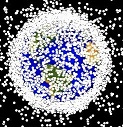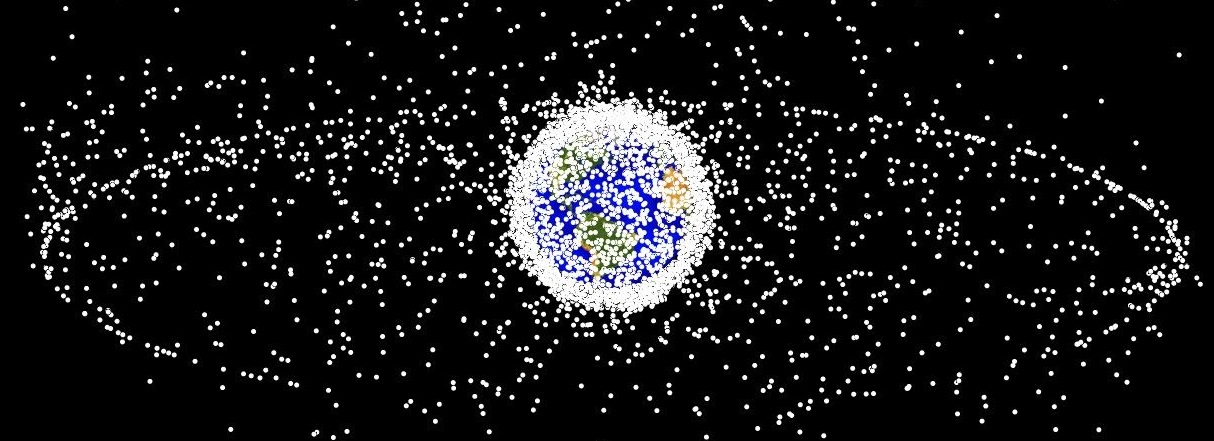|
Désorbitage par Trampoline Systeme avec traduction en français Version 1.2 Copyright ©2017 by Paul Niquette. All rights reserved. |
|||||||||
A visualization
of orbital debris.
NASA
Orbital Debris Program Office
 As of this writing
(mid-2017) some 18,000 man-made objects are
orbiting the earth, including more than
1,400 operational satellites (see Table 1).
Mankind depends on uncountable applications of
space technology; many of the most
vital applications can be categorized as
follows:
As of this writing
(mid-2017) some 18,000 man-made objects are
orbiting the earth, including more than
1,400 operational satellites (see Table 1).
Mankind depends on uncountable applications of
space technology; many of the most
vital applications can be categorized as
follows:{1} Astronomical Observations are conducted by Hubble in orbit above the atmosphere. {2} Broadcasting Networks are supported by hundreds of geostationary earth orbits. {3} Communication Services use constellations of satellites in polar orbits. {4} Intelligence Gathering must operate at low orbital elevations for close-up imaging. {5} Mapping Services are operated by governments and businesses worldwide. {6} Meteorological Imaging satellites operate in synchronous or geostationary orbits. {7} Navigation Services use upwards of a hundred satellites in three constellations. {8} Scientific Experiments are conducted in a wide range of satellites. {9} Space Station, most prominently the ISS, is deployed in a low-earth orbit (LEO). {10} Debris Remediation requires specialized satellites deployed in various orbits.
Since the beginning of the present century, the growing amount of man-made space debris in the vicinity of our planet has become a hazard to active satellites and spacecraft -- a threat, which is now far greater than micrometeoroids. All objects in space travel in orbits. A typical object in low-Earth-orbit (LEO) is traveling at 28,000 km/h (17,500 mph). Never mind head-on or oblique-angle collisions, consider the case of a satellite and a piece of space debris traveling at the same velocity in orbits that cross each other at merely one degree. They would collide with a relative velocity of 490 km/h (305 mph). About like a dragster sideswiping a parked minivan.Mankind ought to be embarrassed to look back over six decades at the reckless way nations of the world have treated the orbits of the world...
Inasmuch as collisions with debris produce more debris, the resulting avalanche of destructive events, called the Kessler Syndrome, may soon enough render Earth orbits impassable for centuries. Already, an average of one satellite is destroyed per year.
 Every
object in orbit will eventually
get dragged down into the
atmosphere. The value of
the word "eventually" can be
immense, depending on orbital
elevation. Note {4} in
Table
1 reads, "Satellites or space
debris in orbits at or below
~250 km (155 mi) will burn up
in the atmosphere within one
year."
Every
object in orbit will eventually
get dragged down into the
atmosphere. The value of
the word "eventually" can be
immense, depending on orbital
elevation. Note {4} in
Table
1 reads, "Satellites or space
debris in orbits at or below
~250 km (155 mi) will burn up
in the atmosphere within one
year."Orbital decay can take a mighty long time. That's good news for all of the satellite applications listed above. As for debris...not so much. To reduce hazards for spacecraft transiting debris-filled orbits, mankind urgently needs to figure out how to hasten the orbital decay of debris -- hey, to deorbit debris.According to the NASA Orbital Debris Program Office, addressing risks to the current fleet of operational spacecraft, calls for remediation measures that emphasize the removal of small sized debris. However, the control of long-term sources of fragmentation debris from on-orbit explosions and collisions, calls for the deorbiting of massive objects such as intact rocket bodies and non-functional satellites. Quoting from a recent report: "Studies have indicated that the removal of as few as five of the highest risk objects per year can stabilize the long-term low-Earth-orbit (LEO) debris environment."  The
solution page for the Trampoline
Deorbiting System
puzzle puts forward a
cost-effective proposal for
rapid removal of "highest risk
objects" from low-Earth-orbits,
applying proven space-age
technology in straightforward
designs, which seem not to be
described anywhere on the
Internet. Yet. The
solution page for the Trampoline
Deorbiting System
puzzle puts forward a
cost-effective proposal for
rapid removal of "highest risk
objects" from low-Earth-orbits,
applying proven space-age
technology in straightforward
designs, which seem not to be
described anywhere on the
Internet. Yet.We might define "high risk objects" as [a] satellites which have completed their missions but nevertheless remain in orbit or [b] rocket boosters which have been abandoned perforce into orbits. For brevity, let's adopt the term derelict.Removal of a derelict requires a system designed to perform five generalized tasks: Task 1: Launch and insert spacecraft into parking orbit above derelict orbit.As part of the launch sequence, the spacecraft will be programmed by the ground base control center for autonomous operation. Here and throughout the mission, a form of 'orbital hygiene' needs to be mandated. The rocket stages and spacecraft fairings, for example, must not be discarded into Earth orbits. In that regard, a reusable launch system would be ideal. Task 2: Transfer spacecraft into derelict orbit for rendezvous.The parking orbit matches the derelict orbit in inclination and eccentricity but has a slightly longer period. As the derelict approaches conjunction from below, the spacecraft performs an autonomous orbit transfer maneuver using retrograde burns of its main engine. Task 3: Maneuver spacecraft into position and prepare for capturing derelict.Because of expected irregularities in the structure of the derelict and its random orientation, attitude thrusters on the spacecraft must be operated in a remote robotic mode to make fine adjustments for rendezvous guided from the ground based control center using real-time video information. Equipment on the spacecraft must be deployed and armed as necessary. Task 4: Capture derelict and prepare for deorbiting maneuvers.Various capturing mechanisms have been proposed, including harpoons and lassos and grappling hooks. The most popular mechanism seems to be a huge butterfly-net catapulted from the spacecraft, as shown in this video clip of a test in synthetic weightlessness. Task 5: Transport spacecraft and derelict into disposal orbit.Proposed capturing systems are connected by cable, so the derelict can only be towed by the spacecraft to the disposal orbit. This imposes a technical challenge: The hot flames from the main engine during retrograde burns must be prevented from prematurely cutting the cable.
 |
|||||||||
